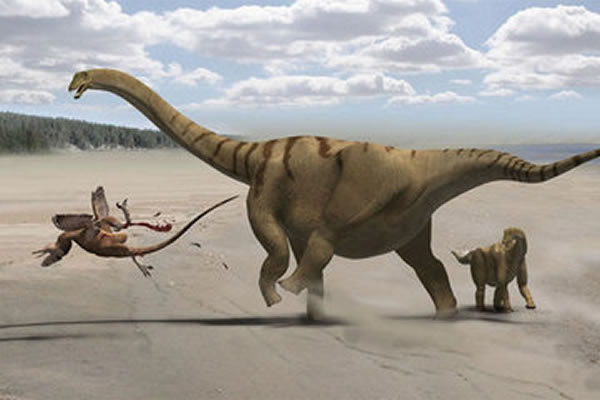How Dinosaurs Grew The World's Longest Necks
Plant-eating dinosaurs called sauropods had the longest necks in the animal kingdom.
How did the largest of all dinosaurs evolve necks longer than any other creature that has ever lived? One secret: mostly hollow neck bones, researchers say.
The largest creatures to ever walk the Earth were the long-necked, long-tailed dinosaurs known as the sauropods. These vegetarians had by far the longest necks of any known animal. The dinosaurs' necks reached up to 50 feet (15 meters) in length, six times longer than that of the current world-record holder, the giraffe, and at least five times longer than those of any other animal that has lived on land.
"They were really stupidly, absurdly oversized," said researcher Michael Taylor, a vertebrate paleontologist at the University of Bristol in England. "In our feeble, modern world, we're used to thinking of elephants as big, but sauropods reached 10 times the size elephants do. They were the size of walking whales."
Amazing Necks
To find out how sauropod necks could get so long, scientists analyzed other long-necked creatures and compared sauropod anatomy with that of the dinosaurs' nearest living relatives, the birds and crocodilians.
"Extinct animals — and living animals, too, for that matter — are much more amazing than we realize," Taylor told LiveScience. "Time and again, people have proposed limits to possible animal sizes, like the five-meter (16-foot) wingspan that was supposed to be the limit for flying animals. And time and again, they've been blown away. We now know of flying pterosaurs with 10-meter (33-foot) wingspans. And these extremes are achieved by a startling array of anatomical innovations." [Image Gallery: 25 Amazing Ancient Beasts]
Among living animals, adult bull giraffes have the longest necks, capable of reaching about 8 feet (2.4 m) long. No other living creature exceeds half this length. For instance, ostriches typically have necks only about 3 feet (1 m) long.
When it comes to extinct animals, the largest land-living mammal of all time was the rhino-like creature Paraceratherium, which had a neck maybe 8.2 feet (2.5 m) long. The flying reptiles known as pterosaurs could also have surprisingly long necks, such as Arambourgiania, whose neck may have exceeded 10 feet (3 m).
The necks of the Loch Ness Monster-like marine reptiles known as plesiosaurs could reach an impressive 23 feet (7 m), probably because the water they lived in could support their weight. But these necks were still less than half the lengths of the longest-necked sauropods.
Sauropod Secrets
In their study, Taylor and his colleagues found that the neck bones of sauropods possessed a number of traits that supported such long necks. For instance, air often made up 60 percent of these animals' necks, with some as light as birds' bones, making it easier to support long chains of the bones. The muscles, tendons and ligaments were also positioned around these vertebrae in a way that helped maximize leverage, making neck movements more efficient.
In addition, the dinosaurs' giant torsos and four-legged stances helped provide a stable platform for their necks. In contrast, giraffes have relatively small torsos, while ostriches have two-legged stances.
Feb 24, 2013 10:45 AM ET by LiveScience












